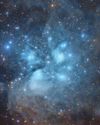Prøve GULL - Gratis
Newborn star's X-rays shine light on Solar System's early days
All About Space
|Issue 106
In a new study, astronomers report the first detection of X-rays from a Sun-like star in the earliest phase of its evolution. This discovery may help scientists explore the earliest days of our Solar System and rewrite cosmic history.

In 2017 the Chandra X-ray Observatory detected an X-ray flare coming from the very young star HOPS 383, which is the same type of star as our Sun. The star, known as a ‘protostar’ because it’s in the earliest phase of star evolution, lies about 1,400 light-years away from Earth and will grow to have about half the mass of our Sun.
In the new research, scientists studying the X-ray flare, which lasted for three hours and 20 minutes, gained insights that change our understanding of when stars like our Sun begin emitting high-energy radiation into space.
“We don’t have a time machine that lets us directly observe our Sun as it was beginning its life, but the next best thing is to look at analogues of it like HOPS 383,” said Nicolas Grosso, of the Astrophysics Laboratory of Marseille at AixMarseille University in France. “From these we can reconstruct important parts of our own Solar System’s past.”
While scientists know that young stars more actively emit X-rays than older stars, it hasn’t been clear exactly when stars begin emitting X-rays. According to Grosso and his team, the new finding “resets the timeline for when astronomers think Sun-like stars start blasting X-rays into space.”
Originally, the researchers didn’t observe X-rays coming from HOPS 383 outside of this flaring period, implying that outside of the flaring period the object was at least ten-times fainter than when the flare was at its maximum. They also found that the flare was 2,000-times more powerful than the brightest X-ray flare that has been observed from our Sun, a much older star.
Denne historien er fra Issue 106-utgaven av All About Space.
Abonner på Magzter GOLD for å få tilgang til tusenvis av kuraterte premiumhistorier og over 9000 magasiner og aviser.
Allerede abonnent? Logg på
FLERE HISTORIER FRA All About Space

All About Space UK
MYSTERIES OF THE UNI WHERE ARE ALL THE SPIRAL GALAXIES?
There are far fewer spiral galaxies than elliptical ones in the Supergalactic Plane, and scientists are keen to discover why
7 mins
Issue 161

All About Space UK
ZOMBIE STARS
+10 OTHER TERRIFYING SPACE OBJECTS
8 mins
Issue 161

All About Space UK
HOW TO BEAT LIGHT POLLUTION
Thought it was impossible to observe the wonders of the night sky from towns and cities? Think again. Follow our tips and tricks on successfully observing through sky glow
2 mins
Issue 161

All About Space UK
15 STUNNING STAR CLUSTERS
These beautiful stellar groupings are spattered across the cosmos
8 mins
Issue 161

All About Space UK
Eileen Collins "It was a difficult mission...we were the first to see Mir"
Having served as both the first female pilot and first female commander of NASA's Space Shuttle, Collins boosted the involvement of women in space exploration to a whole new level
9 mins
Issue 161

All About Space UK
MARS LEAKS FASTER WHEN IT'S CLOSER TO THE SUN
The Red Planet has lost enough water to space to form a global ocean hundreds of kilometres deep
2 mins
Issue 161

All About Space UK
FUTURE TECH KANKOH-MARU
This ambitious reusable spacecraft will be capable of taking 50 people to and from orbit
2 mins
Issue 161

All About Space UK
THE FINAL FRONTIER
Beyond the reach of the Sun is a fascinating region of the cosmos that were only just beginning to explore
8 mins
Issue 161

All About Space UK
A long-lost moon could explain Mars' weird shape and extreme terrain
A long-lost moon could explain why Mars is so different from the other rocky planets in the Solar System. Today Mars has two tiny moons.
2 mins
Issue 161

All About Space UK
A sprinkling of cosmic dust may have helped kick-start life on Earth
Cosmic dust may have helped kick-start life on Earth. New findings challenge a widely held assumption that this wasn't a plausible explanation.
3 mins
Issue 161
Translate
Change font size

